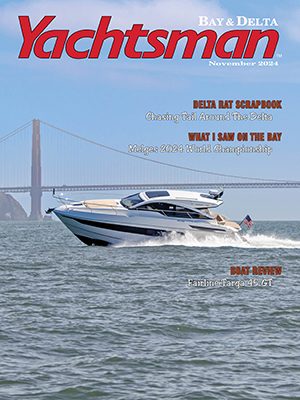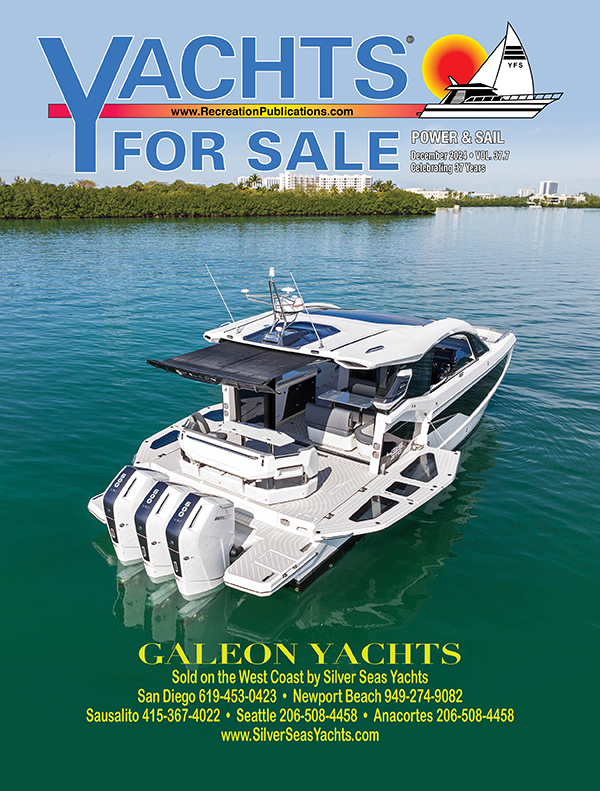What I Saw – by Jackie Philpott

Race To Alaska
In early June my husband (aka The Voice of Reason) and I took a road trip up to the State of Washington to watch the start of the Race to Alaska, aka the R2AK. It was a two-day road trip that required a full carafe of coffee from Oakland to Grants Pass, Oregon, arriving the next day in Port Townsend three lattes later.
The qualifier for the Race to Alaska is the 40nm trek from Port Townsend via the Strait of Juan de Fuca, to Victoria, British Columbia. For the qualifier you need only a flotation device of some kind (boat, standup paddleboard, kayak or canoe) and a passport. No engine allowed. No outside support allowed. The race committee provides you with a tracker and then they send you on your way.
The Race to Alaska’s true start is in in Victoria, and that race is another kettle of fish altogether. It is from Victoria that the fleet makes its way up through the Inside Passage to Ketchikan, Alaska. If you are interested, here is a video about it: https://r2ak.com/r2ak-movie
If you don’t want to watch it, just read about it here, look at my photos, call it a day.
Some boats get towed by trailer to Port Townsend, some sail, row or paddle in from somewhere in the world. This year there was a Dutch fella from Australia and an Israeli from Hadera. There are always lots of locals from the Pacific Northwest, Californians and Canadians. And yes, Canadians are spectacularly courteous.
It is fun to walk the docks, look at the boats and talk with their skippers. I’ve done this twice before, once in 2018 and again in 2019 when we followed the fleet up to Victoria Harbor. It’s best to chat with the skippers early, before they get bored by the attention and/or skittery as the race approaches.
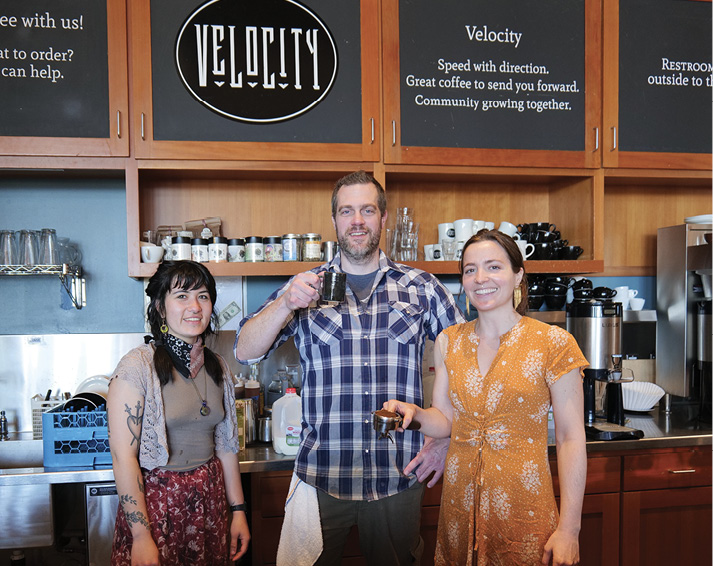
The Wednesday of our arrival was a beautiful, sunny day. After settling in at the Swan Hotel, I walked over to Velocity, a great little coffee house that is located in the Northwest Maritime Center. The Race to Victoria would begin at 5 a.m. on Saturday morning. Danielle, one of Velocity’s very pleasant baristas, promised that coffee and fresh pastries would be served before 4 a.m. on the morning of the race. She finds it “exciting to be part of such an epic journey.”

The small Point Hudson Harbor is where the race is staged, and regular slip holders are asked to vacate their slips for two days so the boats can gather together before the start of the race. I walked up to the wraparound balcony of the Northwest Maritime Center and looked all around. What was this? I heard the distinctive sound of a drone: Like a small airplane or a huge mosquito. Below me I saw two young men who looked suspiciously like drone-drivers. I made a beeline for them.
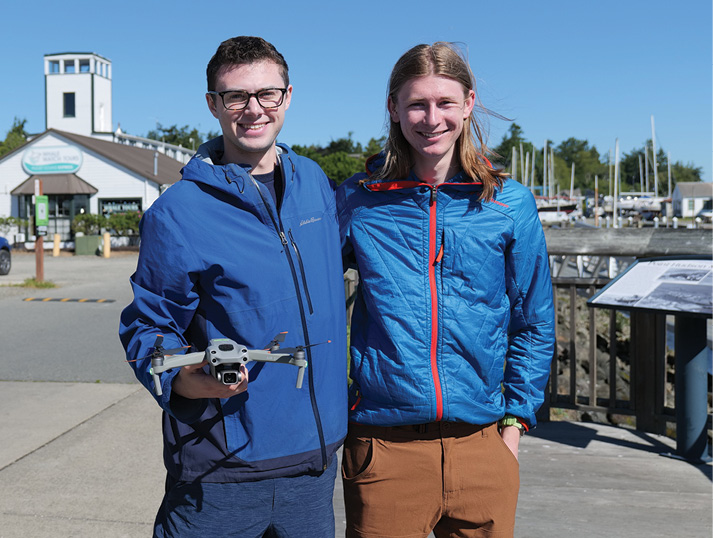
Garret Weintrob and Ryder Booth are members of the media team for the R2AK. Ryder’s dad and aunt, George and Stina Booth, have raced twice before in what was described as “a rowboat.” Actually, it was an 18-foot, 11-inch custom faering rowboat, which is much fancier than a mere rowboat.
They were Team Solveig. If you click or copy and paste here you can watch a video, which Ryder edited.
Garret and Ryder will follow the race up to Ketchikan aboard Peter Geerlofs’ 40-foot luxury trawler Seaducktress. Ryder said his understanding is that the boat even has a shower aboard. Whoa. It sounds like luxury to me.
Jay Moore Of Team Hullabaloo
As I headed toward the other side of the harbor, I walked by a fella standing next to a red truck. I could tell from the detritus in its cab that he had something to do with the race. He was joking with a passerby about his crew drinking all the Modelo he had on hand (and he had a lot) before they started the race.
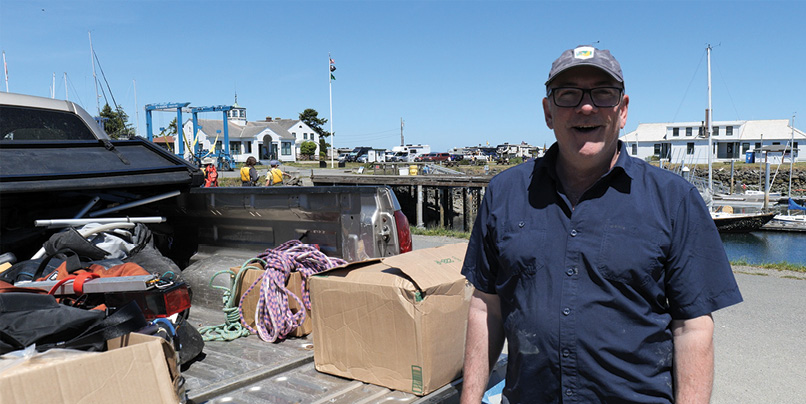
I introduced myself to Jay Moore of the trimaran Hullabaloo. He told me this:
“There are four of us on Team Hullabaloo. Bill Woodruff and I have raced my Catalina 30 and his J-105 in the San Francisco Bay. Hullabaloo’s owner is Jonathan Kaplan and his son is Jacob Kaplan. I did all of the provisioning for this boat. I can’t believe how hard it has been to provision for four people!”
I asked about the bale of sawdust. It was in the back of his truck, next to the beer cooler. Jay explained that the sawdust was for the boat’s composting toilet. Ah. That stopped me in my tracks. Of all the provisioning I might have considered for the Race to Alaska, sawdust for a composting toilet was not on that list. EPIRB? Yes. Tethers? Yes. Water-impervious navigation aids? Yes. Never a composting toilet.
As they might say in a courtroom, “Your honor, that opens the door to evidence and the witness to the following line of questioning.” I felt it was fair game to comment upon the foods Jay had chosen for the crew.
Jay started listing his provisions: Freeze dried foods.
To which I replied: “Binding.”
He laughed and added, “Oatmeal.”
“Also binding,” said I.
Jay had already considered that and had also brought two heads of cabbage and an onion, which he plans to add to every meal. Cabbage and onion added to freeze dried food?
“Yuuuuck!!!” I said.
Jay was completely unfazed by this uncouth stranger. He said, “I have to watch my cholesterol, because my doctor said I’ll die if I don’t. And Jacob eats like a dozen eggs a day. The two of us have widely disparate dietary needs. We are taking fresh eggs, which keep well without refrigeration. We have a lot of hydrofood that we’ll cook with a jet boil. I like the Pinnacle brand freeze-dried food, which is also binding. But there are methods to address that. We have lots of chocolate on board. A square of chocolate twice a day takes care of the binding problem just fine.”
I remain skeptical. But sometimes, with strangers in parking lots? You just have to agree to disagree. I asked about their racing strategy.
Jay said, “Sailing Hullabaloo has been an interesting learning experience. Bill and I are pretty seasoned monohull racers and honestly, we didn’t quite trust the tri. The amas fold and there’s only a pin holding them in. It’s a little unnerving to a monohull sailor. But they’re proven ocean racers so it’s not like it’s a flaw in the design, it’s just that we’re not used to it. Also, we were unfamiliar with how much heel we can put on the boat before bad things could happen.
“We’ve stressed the boat and the rig and I think we’ve learned how to race it well. You know, you race in the Bay and you’re doing 25-30 knots routinely, so we’ve done heavy weather in the boat and not hurt ourselves or the boat. And we had fun together. That’s the big thing.”
As far as strategy for this race?
Jay said, “Our strategy is to pray for a reaching wind. It’s important because the trimaran can’t point. This is why the Schock 40s have done really well the past couple of years. Because there has been a northerly wind. But. The forecasts have said that it’s clocking west. And if it clocks west and we can actually get one ama up, we can do 20-22 knots. And there’s no Schock 40 on the planet that can take us at 20 knots.
“The only thing we’re not completely certain of is a strategy for floating logs at night. We talked to a guy who did this race a couple years ago, a harbor pilot named Pat. He told us, ‘Spotlight on the bow. Put one guy on the bow with 1500-2000 lumens to call out logs and you’ve got enough room to send it between the amas.’ So, that’ll be our strategy. Our sleep strategy is two on, two off, four-hour shifts, one person at the bow, one at the tiller.”
I asked about their autopilot and Jay batted the question away with a swipe of his hand.
“What autopilot? We’re racing! We’ll be done in four days. There’s going to be a hand on the tiller 100% of the time from here to Ketchikan. There is no autopilot involved. We figure we’ve got a decent shot. If it’s a reaching wind and we can get one ama just touching the waves, then we are gonna scream up. If it’s on our nose then the Schock 40’s gonna kick our butts all the way because they can point and we can’t. So, we’re either gonna tack a thousand times or go straight.”
Interview With Jacob Kaplan
The next day I had a chat with another member of Team Hullabaloo, just before the team raised the mast in their slip.
Jacob Kaplan had this to say: “We’re all from the San Francisco Bay. Our fearless leader is my dad, Jonathan Kaplan. I grew up sailing dinghies out of the St. Francis and I also race 110 Internationals with my dad out of Inverness Yacht Club on the Tomales Bay.
“I thought that my dad and I were crazy for doing this race but looking around at these 31-foot trimarans, they are pretty much just glorified dinghies. Glorified kayaks! I feel like we are playing it safe by comparison.
“The stakes are higher but it’s just as easy to capsize this boat. Well, maybe that’s a bit of an overstatement, but we’ve definitely found the edge. We were doing a beer can race on the San Francisco Bay and a big old puff came in while we were rounding Blackaller, just inside the Golden Gate Bridge. This ama was 6 feet in the air. The daggerboard was sticking out, just barely in the water.
“Regarding our strategy? We hope not to turtle. There’s a guy, Liam, on the Contessa 26 (Team Fairly Fleabag). He sailed alone here from Canada. He told us that he had found the water between here and there to be log free. We’re kinda counting on his experience.”
More Dinghy Sailors In The Race
On Thursday morning I walked down to check out the Santa Cruz 27 Crazy Rhythm. John Simpson raced this boat in the 2018 Singlehanded Transpac race, and I expected to find him there. Instead, I found Tim Duncan and Rich Treadwell of the San Francisco Bay, who had bought the boat from John just one month earlier. When I arrived, they had just raised the mast, the shrouds were wiggly and the fellas were still attaching everything. They were having a wonderful time.
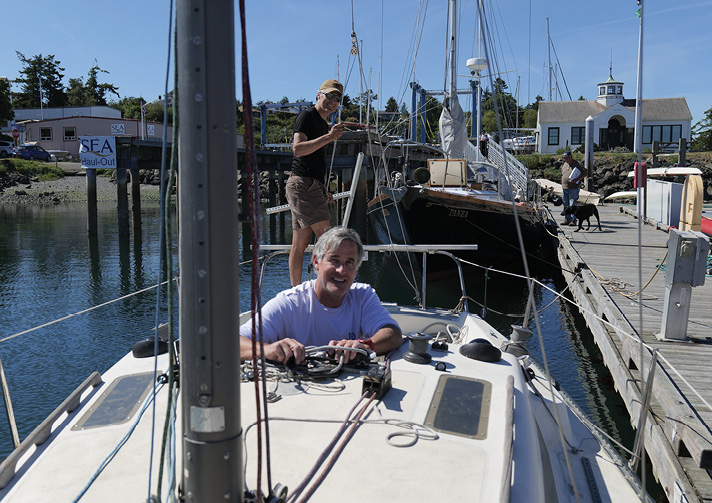
I asked how much experience they had on this boat. At first Tim attempted to bluff. He said, “Oh! A LOT!” Rich nodded in agreement but I could tell they were lying. Then he admitted, “Well, two races in the South Bay and one in the estuary. And we absolutely ripped it up!”
What about their sails?
“The very best, state of the art sails that could be purchased in 2018 which were then used by John in the 2018 SHTP.” By this time, we were all laughing. We all know that serious racers buy new sails for important races.
Both fellas wanted me to be sure to give John Simpson a lot of credit for helping them prepare Crazy Rhythm for this race. He bent over backwards to help, told them all about his own preparations for the 2018 SHTP and offered them what they called “a turn key” experience. John told them he was pleased that Crazy Rythm would be used in a new adventure. I asked about their strategy for this race.
“Given our vast experience aboard this Santa Cruz 27… we are ready to crush this race! But only as far as Victoria.”
I asked what kind of boats they sailed before buying this boat. Tim laughed and told me that they are dinghy sailors in Tomales Bay. They are only sailing the qualifier to Victoria this year and their plan is to return in 2026 for the full race to Ketchikan. Certainly, I look forward to watching them when they do that. Dinghy sailors in the R2AK. It’s the new thing.
The Hyde Sailing Dynasty
Continuing down the dock, I introduced myself to a group of men – some young, some older – aboard S/V Amurskaya, a 10-meter Flying Tiger sailboat I recognized from the 2022 R2AK.
I spoke with Rob Hyde, and asked whether everyone aboard was a Hyde family member. His response?
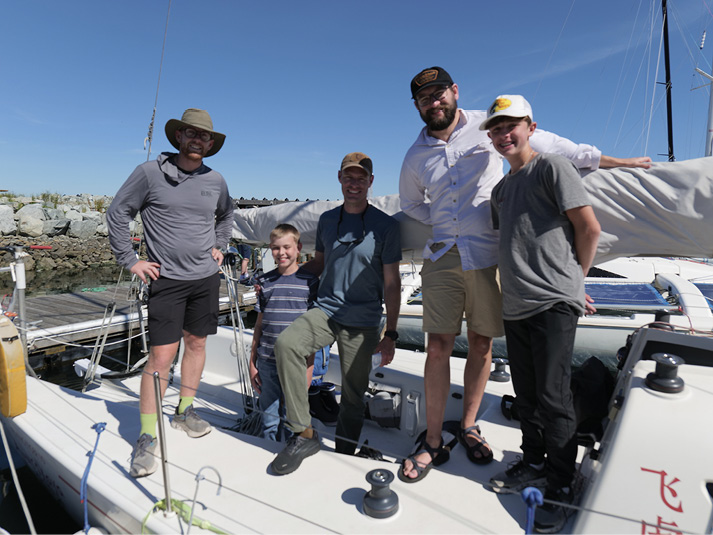
“Everyone aboard is either family or like family.” What a gracious way to describe close friends.
Rob told me that the previous owners of the boat had heard through the grapevine that he was looking for a boat to sail in the R2AK. Because of silting in Port Roberts it was difficult for the previous owners to get Amurskaya into and out of its slip. Rob was asked whether he wanted to buy it so he did. The Hyde family and like family are only going to Victoria this year. If they all agree that they enjoyed the trip they will come back again, do the entire race to Ketchikan in 2026. The younger Hyde members currently sail Hobie 18s and Flying Scots. It will be interesting to see them again in 2026. Two years to plan for the R2AK: What will their strategy be?
Ohad Safrir, Team Spirit Of Nevetz
I interviewed Ohad Shafrir, who was provisioning his boat on the beach next to the Maritime Center. Ohad sails on the Mediterranean, out of a place called Caesarea Sea Center, between Tel Aviv and Haifa. His boat is called an XCAT, and is a very small, Hobie Cat type sailboat with one mast and two sails. The rowing system Ohad will use was engineered by an Austrian named Joachim, and enables rowing forward rather than backward. A similar system is called the Forward-Facing Rowing System, and is sold by Gig Harbor Boatworks: https://ghboats.com/options/accessories/forwardrow/
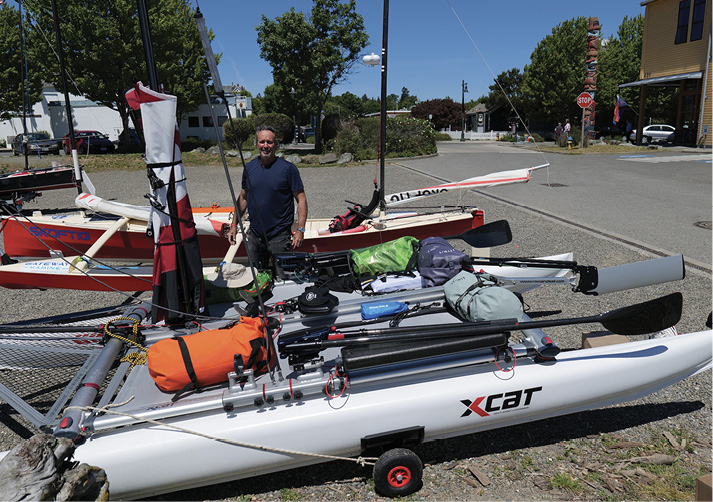
Ohad will also use an invention created by a high school science team in Massachusetts, that automatically pivots the blade to perform the feathering action. I read about this mechanism here:
https://lemelson.mit.edu/teams/northampton-high-school-inventeam
The appeal of this particular boat, according to Ohad, is that “you can take it apart in half an hour, put it on the roof of your car, you take it home or wherever you want. When you want it again you put it back together in half an hour and you have a combination rowing and sailing boat. It’s plastic so it’s indestructible and the rowing system is ingenious.”
I was gently skeptical and asked about spares. Ohad said “I don’t have a lot of space on the boat so I hope I planned it right. I have a spare pair of oars.”
I asked about food and Ohad pointed to two dry bags. He also has Navionics software on one of two cell phones. That’s it. Two bags of food. Two cell phones.
He’s an awfully nice man and I sure hope he stays safe. I gave him two dark chocolate bars as my contribution to his trip. As of this writing, Spirit of Nevetz remains in relatively protected waters. According to forecasts, the wind is a comin’, though, and to finish the race in time he will have to venture out to more open water. I wish him well. Singlehanding is one thing. Singlehanding on an itty-bitty exposed boat seems like a whole lot of scary to me. But you know what? I am confident that this sailor will continue on to finish in Ketchikan. And his kind of tenacity is what the R2AK is all about.
Throw Caution To The Wind
The day before the start of the Race I introduced myself to Anne McCormack and Julie Miller, who were sitting aboard a San Juan 24 sailboat tied up to a slip. They represented half of the Team Loose Screw. It is small with low freeboard, and Emily, the owner of the boat, found it for $250 on Craigslist. Emily and Holly, the two other members of the team, had just left to get R2AK tattoos.

Once introductions were complete, I asked: Whose bright idea was it to enter this race??
Julie Miller told me this:
“Emily got the boat and was interested in doing this race. She posted on a Facebook site, Women Who Sail, and lots of people responded. She talked to a bunch of people and then put a team together. We just sailed up from Bainbridge Island.”
Anne McCormick told me the story of the rigging: “Julie and Holly said, ‘Let’s tune the rigging’ and POW! One of the turnbuckles just broke off. So, Emily ordered all new turnbuckles from Fishery Supplies. Then we had to re-tune the rigging because the shrouds started wobbling. We got ‘em re-tuned yesterday. This is a 1975 boat and all the standing rigging is original except for the turnbuckles. Those are brand new.
“The new mainsail has two reefing points. We have a genoa and both a symmetric and an asymmetric spinnaker. Somebody gave Emily the asym. We don’t think we’ll use it too much in this race. We put our spinnaker up the other day but we didn’t keep it up long. We were trying to raise it with the sock and then the sock wouldn’t pull down properly and so we decided, ‘Ok, forget the sock’.”
Anne learned to sail on sunfish when she was 17 years old on the great south bay off Long Island. Then she went to college in Boston and sailed on the Charles River. Then she came to Washington and sailed out of Shilshole Bay Marina in Seattle. After a long hiatus from sailing, she decided to do this race and took sailing classes to refresh her sailing skills.
Julie grew up in Chicago and then moved to Boston. She had a hard time falling in love with Boston and decided that she needed to find a way to fall in love with the town. She learned about the Wooden Boat School where she took a week long first level sailing class, and that was the answer to appreciation of Boston. Julie has spent much more time sailing on larger boats, which is a completely different experience than sailing on a San Juan 24.
I asked them about their strategy for this race. Did they plan to stop during the night? No. Jules said, “Our plan is to sail as much as we can. To keep going as much as possible.” Anne added that they plan to stay out of the shipping lanes. Their priorities are: “Stay safe, have fun and finish.”
Jules mentioned that they are hoping for the R2AK Dirtbag award and we laughed about having such a modest ambition. Jules said wistfully, if facetiously, “We can only hope.”
As we shook hands, I invited them both to come down to the San Francisco Bay to sail with me. Anne reminded me that the boat’s name is Caution. The Team’s Slogan is: We’re throwing Caution to the Wind.
Paul Gibson Of Team Malolo
In 2019 the S/V Dragon was favored to win this race by almost everybody who understood the difference between one race boat and another. In that year I interviewed Tom Casper and Guy Rittger of Dragon immediately after they and their skipper, Duncan Gladman, arrived in Victoria. In the 2019 R2AK Dragon was called Team Pear Shaped Racing and the boat was destined to win – until it hit that log.

Here is that interview: https://vimeo.com/403495347
This year I spoke with Paul Gibson of S/V Dragon. Her name this year is Team Malolo. Paul had this to say:
“In 2019 this boat did the race with three people. They got the steak knives that year. The same two people have owned this boat the whole time. Neither of them are on board. They’ve been gracious enough to loan it to us for the race. Duncan, the skipper, has done the race on this boat twice and done the race five times. This will be my second attempt and his fifth. We’re all looking forward to it.”
We’ve got a couple of newbies to the boat: Matt and Becky have been sailing with me on my little Hotfoot 27 for the last six years. Hotfoots were built up in Canada back in the 80s. Our strategy is to sail as fast as we can. We’ve got a tandem bike on the back and we’ve got a little more gear than before, trying to stay warm and comfortable so we’re as fresh as we can be the further we get north.
We’ll probably do half hour shifts. This boat, when you’re moving good on it, you can sustain about 2.5 knots. There will be other boats that will be faster. The crew of the Schock 40, Team Stranger Danger, say they can do about 3.5 knots but I don’t know if that’s during a sprint or what it is. They’ve got four recumbent seats with four people pedaling at a time. But they’ve got eight people on board overall, so they’ve got a lot of weight on board that boat for sure.
But there’s all kinds of conditions where we’re faster than them. We can actually go upwind in breeze, we think, faster than they can. A lot of people don’t think that, but this boat, with its big dagger board and the sea foils, can go upwind fairly well.
The bigger multis, and for sure the Schock 40 will be our competition. And everybody’s in it. If you look at the records over the last number of years, a lot of 30-foot monohulls have done very very well in this race. So, there’s an argument to be made that the multihulls are a little bit more fragile for this – we’ve certainly proved that in the past – and so we’re just gonna have to wait and see whether we hit a bunch of stuff this year.
We’re always gonna have somebody watching while somebody else is driving at night, but when we hit logs? We’re looking and we just don’t see ‘em. We would like to have the logs go between our amas, but if we can’t see ‘em, there’s not much we can do about it. They sit in the trough of a wave and you come over and there’s a log? You don’t get a choice. And being a multihull there’s three times as much stuff to hit in the water than a monohull has. So, our odds are higher at hitting them.
We have one new sail. The same sailmakers who have been in town for years, they started a north loft in Victoria. They’re good sailmakers, for sure and we’re happy with it. We’ve been friends with them for years. They’ve helped us out over the years, they know the boat well and they built us a great sail.
Morning Of The Race
On the morning of the race, I woke at 3:30 a.m. and crossed the street in the dark. Heading to the pier overlooking the entrance to the small harbor I joined a line of joyful, quietly laughing people. We slowly made our way in the dark, red lights on our headlamps as we walked over to watch the boats leave their slips and head to the start of the race just beyond the seawall.

But first I had to get myself caffeinated. And sure enough, I can attest that Team Velocity was there at 3:45 a.m. on Saturday morning. They had set up a small cave made of sheets laid over tables with blankets and big pillows underneath for sleepy children whose parents wanted to see the start of the race. It was a “takes a village to embrace teeny future sailors” set-up.
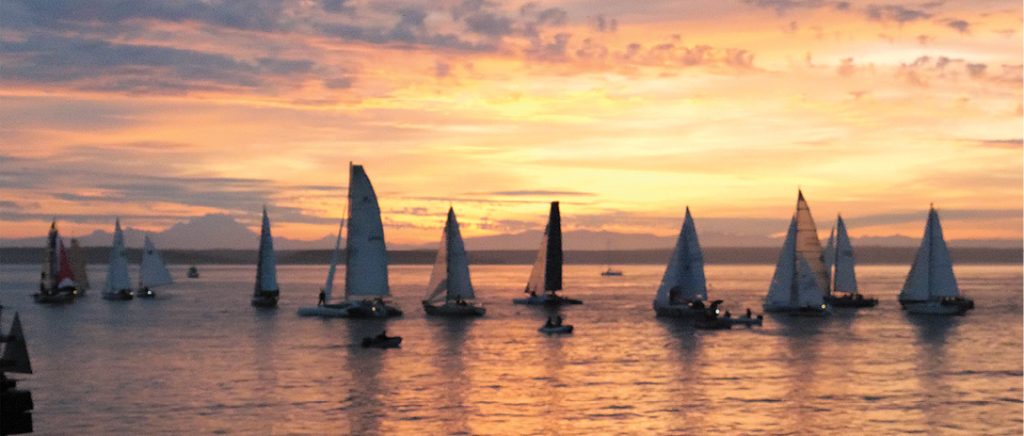
It was incredibly impressive to see the thousand plus people lined up along both piers to watch the boats make their way out of the harbor. There was very little wind in the marina, so crews were rowing and pedalling. People called out to each team as it exited the harbor as they passed beneath us on the water. I videotaped every boat and will make it available in this column come September. Stay tuned.
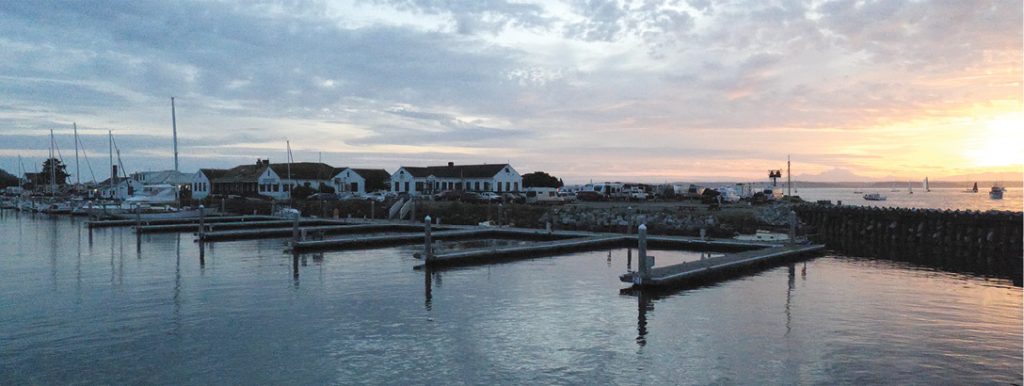
Owl Harbor Annual Nautical Swap Meet
On June 15 I was in the Delta again, having driven up for the Owl Harbor Swap Meet. First off, I met Bob and Steve who were selling a “fully restored” West Wight Potter 15, with a perfect trailer and a rudder “better than the original.” The WWP was my first sailboat. They really really wanted me to buy that boat. I told them, “Oh no, I already have two boats. My husband would kill me if I brought another one home.”
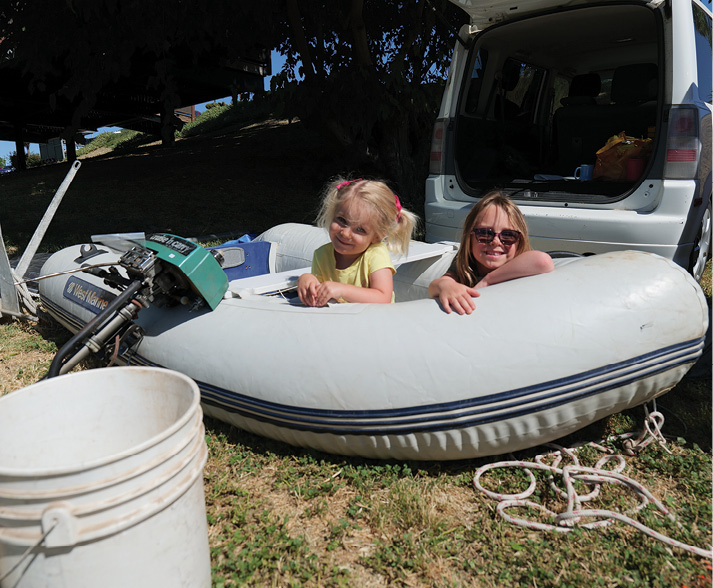
Bob told me I needed a new husband, one “who has his priorities straight.”
I watched Tillie and Ripley call out: “Daddy! Daddy! Can we have this boat?” Daddy said, “Yes.” Indeed. Hard to say “no” to those two.
I enjoyed my conversation with Andries from the Netherlands, who was at the Swap Meet to sell his 30-foot Islander sailboat with lots of sails. Andries lives just outside Paradise. Northern Californians will remember that most of the town of Paradise burned to the ground in the Camp Fire of 2018. When it did, the Moose Lodge burned with it. A member of the lodge, Andries will spend the Fourth of July weekend posting flags around town, then he will make breakfast for himself and fellow Moose Lodge members over in the Elks Lodge.

After buying a pair of binocs for $1 (yes! One dollar) and sweet sweet corn on the cob at the Swap Meet, I drove to Korth’s Pirates Lair Café where I met Melissa, Chantal and Jennifer, who is the manager. When I told Melissa that I never win anything, she let me put two tickets instead of just one into the coffee jar for the breakfast or lunch lottery. I put my phone number on the ticket but I haven’t heard yet whether I won. She also reached down below the counter and handed me a classy ball point pen from Scandia Boat Sales.
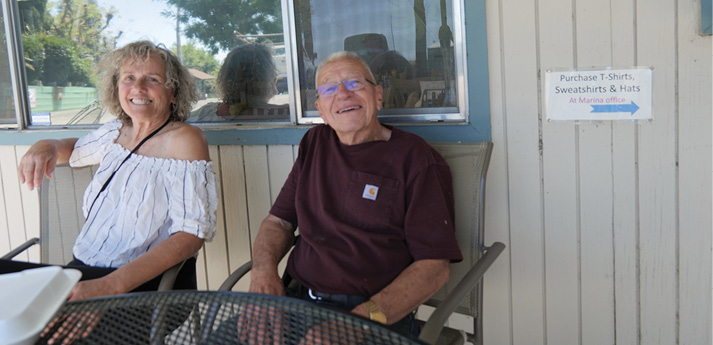
I ordered a club sandwich and sat at the counter to eat it. Then I took everybody’s photograph and headed out to my car. As I was putting my camera into the trunk Captain Jerry called out for me to take a photo of him and his friend, Linda Nash. So, I did.
Captain Jerry’s boat is named Gypsy Ginny, a 28-foot fiberform Spartan fishing boat. He keeps his boat right there in a covered berth at Korth’s and the next time I sail over for lunch or breakfast he’ll show it to me. This was Father’s Day weekend; the river was full of families on boats and everybody was wearing Delta T-shirts. I was, too, and it made me feel right at home.

Correction: In July’s column I wrote about the new business: Berkeley Marine Canvas. I misspelled Apo Winprawet’s last name. Sorry, Apo.
Until next month, thank you for reading. Contact me at jackie@yachtsmanmagazine.com and let me know if you have anything you would like to share. Enjoy your time on the water and let’s all be careful out there.

